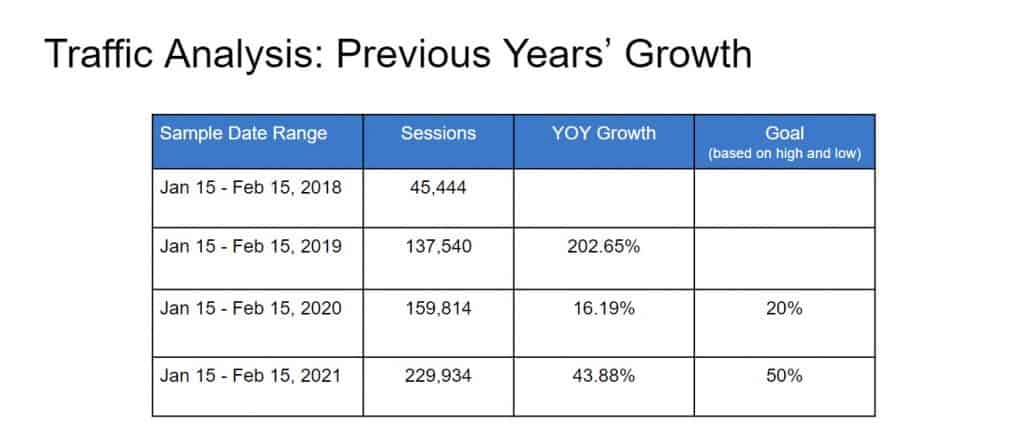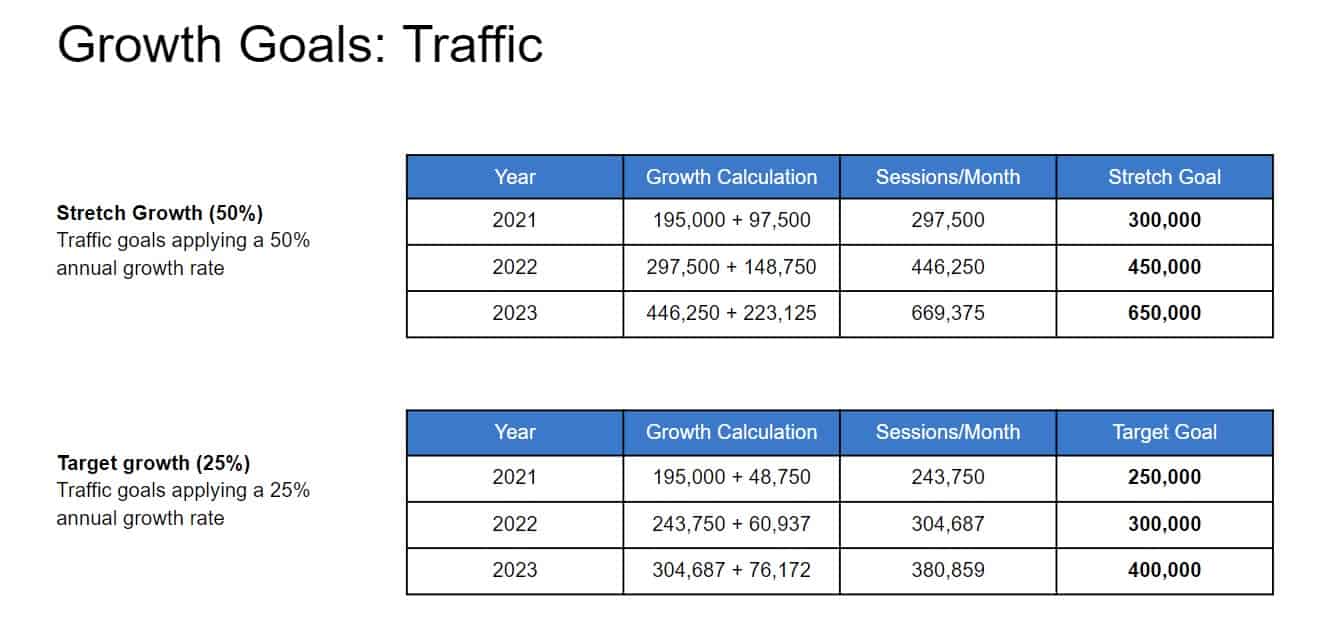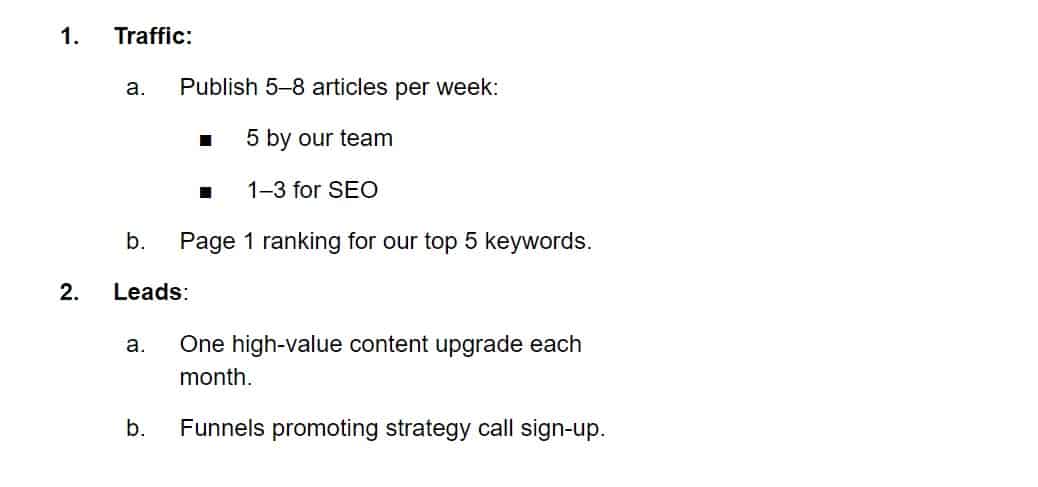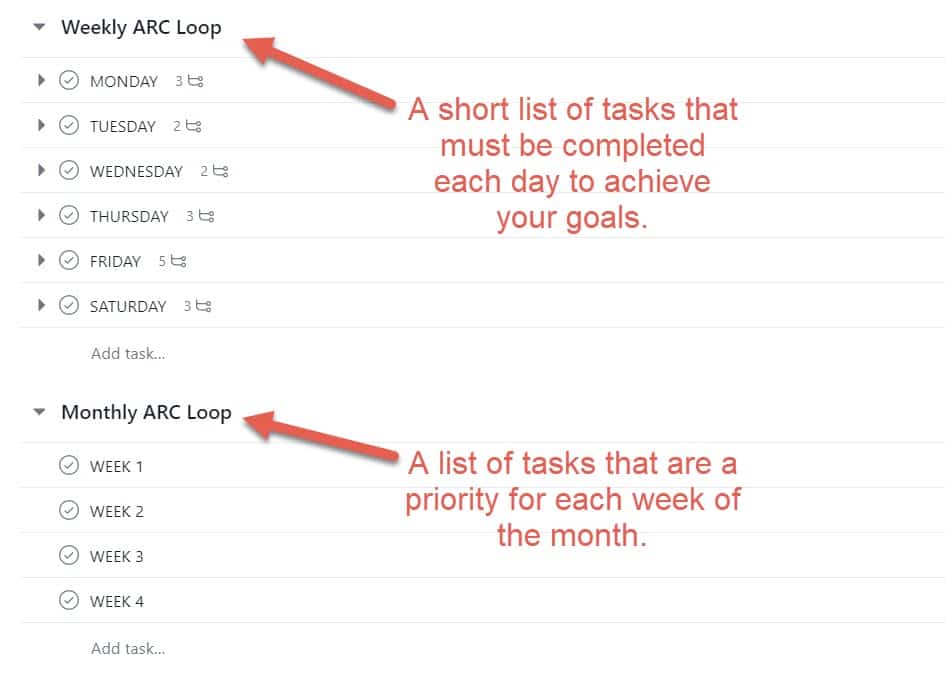Today, I’m going to walk you through a simple process for creating a content strategy that’s painless and can actually improve traffic and conversions.
I’ve run content for several industry-leading brands over the years, and for each, my challenge is this: how to create a content strategy that drives real results while being easy to execute by one person or a small team.
Here’s how I approach it:
1. Set Your Goal
One of the biggest reasons people have difficulty creating a strategy is that they haven’t created a specific goal. You need to know what you’re trying to achieve and how it will impact business growth, so you can create your strategy.
A good strategy includes specific goals (or outcomes) for each area of business growth that content impacts. Because of this, you need to set your priorities.
Decide now on the most important goals so you know how to focus your energies and attention throughout the year.
The most common goals in a content strategy are:
- Traffic
- Owning specific keywords (which is actually a traffic goal)
- Subscriptions (building the brand’s email list)
- Lead generation (for sales)
- Demand generation (for sales)
Generally, my top KPI (key performance indicator) for the entire content strategy is traffic. I also have specific goals for individual parts of the strategy, like the newsletter or blog.
2. Identify Your Target Audience
You need to know who you’re targeting with your strategy.
- Who is your primary audience?
- Where do they hang out online?
- What topics are they interested in?
- What questions do they need answered before they’re willing to buy from you?
You need to know them intimately to be able to engage them with your content. So don’t rush this.
Be aware, you may need to target more than one persona. Make sure you create a content strategy that targets each of your key personas.
For instance, your company may provide a business service to corporate clients and coaching for do-it-yourselfers. Or perhaps you sell two different SaaS products, and each customer group is interested in different topics.
RELATED: Buyer Personas: Everything You Need to Know (a Step-by-Step Guide)
3. Choose Two Primary Channels
A good content strategy builds your brand authority and moves people quickly along the customer journey. So you need to create content that:
- A – Builds authority
- A – Gets attention
- R – Builds relationship
- C – Drives conversions

This is where most content strategies go wrong. Because your content needs to achieve so many different goals, it feels like you need to create an overwhelming amount of content.
In reality, you can hit your goals and create these four categories of content with just two or three channels.
Ideally, you’ll choose one channel to be your primary focus. Then you’ll have another one or two channels that work with your primary channel to create attention, build relationship, and drive conversions.
Creation + Recycling
For individuals and small teams, I recommend two content channels that will hit all four of these areas. Then, create a plan for recycling your content to publish it on other important channels.
For instance, when I launched my business in 2010, I had a blog-first strategy, and social media was my supporting channel.
The blog built my authority and helped me convert new clients. Social media is where I drove attention, networked, and built relationships.
If your blog is your primary channel, you can recycle articles to create YouTube videos or podcast episodes. You can also take snippets from your articles to create social media posts and short explainer videos.
If your newsletter is first, you can publish your newsletter content on your blog. You can talk about the same topics on a YouTube channel or in your podcast.
Two Channels that Work Well Together
It doesn’t matter what channels you choose. Pick two that make it easy for you to create frequent, high-quality content and that your audience enjoys consuming.
Good authority channels include: your blog, your YouTube channel, a podcast, a social media site, or your newsletter.
NOTE: Make sure the channels you choose will help you hit your content goals.
If your #1 goal is to improve organic traffic with SEO, your #1 content channel should be your blog.
If your #1 goal is demand generation, you may need to prioritize off-channel content. An authority book, a YouTube channel, or a digital conference could be your best bet.
If your #1 goal is to drive digital sales, you’ll need to focus on funnel content. Start with lead magnets that will attract qualified traffic (warm and cold), and then reverse engineer your blog content, email marketing, social media, and advertising.
Once you know your starting point, spend some time thinking about how you can leverage content from your #1 channel to build out your secondary channels. This is your recycling plan.
4. Set Your Targets
To create an effective content strategy, think long-term and short-term. Choose a specific number (eg., pageviews or subscribers) you’d like to achieve or a percentage of growth that could help you reach your long-term goals.
There are two ways to approach this.
Option 1: Look at Historical Growth
Sometimes, especially if you don’t have historical data, you have no idea what your targets need to be. In that case, you’ll need to take a guess.
But if you have historical data (Google analytics, anyone?), you can see your growth trends over time and set your goals based on those numbers.

Option 2: Reverse Engineer a Long-Term Target
Let’s say you want to double organic traffic in three year’s time.
Set your long-term target, then reverse engineer the numbers. That will give you your targets for this year.
In this example, I knew I wanted to (at least) double traffic in three year’s time. I used a 50% and a 25% growth rate to calculate two potential scenarios.
The stretch goal (50% growth) would take us well beyond my goal of doubling traffic. The target goal (25% growth) would just hit the three-year target.
This approach ensures we’ll hit our target. But because we’re pushing for the stretch goal, we may actually overshoot it.

Set specific targets for each of your KPIs: newsletter subscribers, leads, sales, etc.
How Will You Get It Done?
Setting your targets doesn’t ensure you’ll achieve them. You need to come up with a plan for making them happen.
For this, you need to think tactically — and realistically. What specifically will you do to achieve your targets?
For instance:

How Will You Measure It?
Always remember, to develop your strategy, you’ll be drawing from your experience and best practices. But you’re guessing. Until you put the strategy to work, you can’t be sure how it will work.
So put your best guess and be prepared to tweak your strategy as you collect data on what works and what doesn’t.
For this, data is your best friend.
Break down your annual numbers to give yourself quarterly, monthly, and weekly goals. For one blog, I set a goal of 50,000 pageviews a week. It was easy, then, to see when traffic had slumped.
When you see your numbers staying flat or, worse, moving downward, you need to quickly assess what’s happening.
Some issues can’t be fixed (like the pandemic). You’ll need to adjust your targets to be more reasonable. But in most cases, your numbers are telling you that your content is missing the mark. You need to test new ideas and figure out what works, so you can get your numbers back on track.
5. Plan Your Workflow
No strategy is effective if you don’t do the work. You need to create a workflow that’s easy to manage.
If your content is published on a weekly basis, it’s easiest to plan your workflow on a weekly basis.
- Mondays: team meetings and writing the newsletter.
- Tuesdays: scheduling content and catching up with contributors/stakeholders
- Wednesdays: writing and editing
- Thursdays: writing and editing
- Fridays: running metrics, analytics
Or
- Mondays: newsletter, client meetings
- Tuesdays: client work, prospect meetings
- Wednesday: FB live and podcast
- Thursdays: client work
- Friday: client updates, analytics
You get the idea.
You may also have some activities that happen on a monthly basis, like a webinar that happens on the first Wednesday of each month. When that’s the case, it’s a good idea to create a monthly workflow that lists the focus for each week of the month.

NOTE: If you work with a team, be sure to assign ownership for each tactic and/or task. If no one owns an activity, it won’t get done.
6. Create Your Strategy Document or Deck
The difference between a daydream and a plan is that a plan is documented.
You can meet or exceed your wildest dreams, but only if you’re willing to write them down, break them down into daily tasks, and put those tasks on your calendar.
So do that now. Write it down, and do it.
By now, you have a solid strategy that’s easy to execute and is certain to drive growth. Your final step is to create your written report.
For this, you can create a written document, a slide deck, or both.
Here are the high-level sections you need to include:
- Business goals
- Strengths and challenges
- Growth plan
- Strategy
Back to You
It’s easy to view content marketing as publishing. With this mindset, you simply create an editorial calendar and churn out content on your key topics.
But today, content marketing is a strategic arm of marketing and sales. It’s more than a blog. It’s your brand’s megaphone to the world.
That being the case, when you create your content strategy, don’t limit yourself to the blog. Think about on-site content, off-site content, and content that will build your authority and drive relationship and sales.


